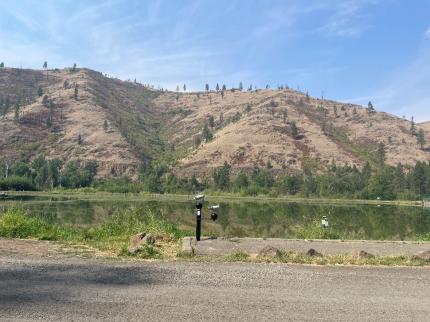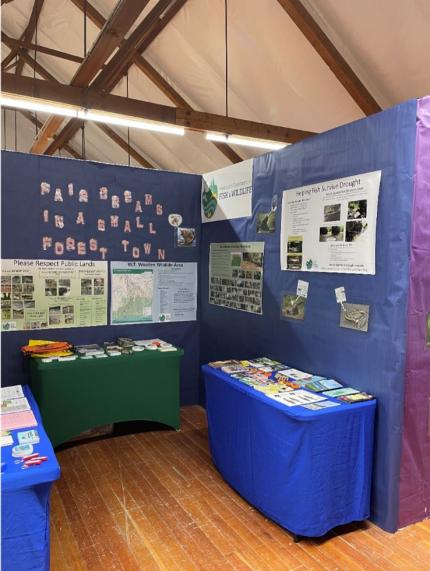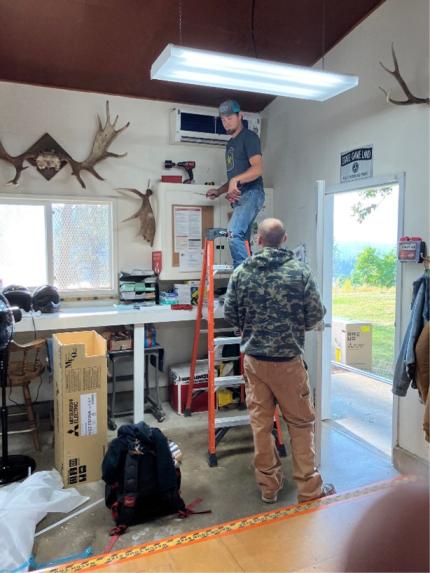Biweekly report Aug16-31 2023 - Region 3 (South Central)
Managing Wildlife Populations
L. T. Murray Wildlife Area Signs: New signs which complement the L. T. Murray Wildlife Area green dot management map were ordered for the elk winter closure area. The signs, containing two informational signs and a map, were relatively inexpensive to replace and will be much easier for a single employee to handle.

Oak Creek Wildlife Area Elk Fence: Oak Creek Wildlife Area annual fence checks and maintenance began on approximately 40 miles of elk fence. This fence stretches from the Cowiche Unit to Cleman Mountain and the boundary with the Wenas Wildlife Area. This fence aims to reduce elk conflict during the winter by limiting movement of elk onto agricultural lands.
Duck Banding Underway Around Washington: Statewide Waterfowl Specialist Wilson assisted District 8 Assistant Wildlife Biologist Moore with waterfowl banding at the Sunnyside Wildlife Area and Bureau of Reclamation property. Swim in traps have been deployed to trap and band ducks for harvest management and to gather information on survival and distribution. The information from recaptured and reported waterfowl bands is used to model harvest, recruitment, and survival, which impact hunting regulations and sex-specific limits. Wilson assists with waterfowl banding projects throughout the state.


Providing Recreation Opportunities
Landowner Hunting Permit Coordination: District 4 Wildlife Conflict Specialist Hand met with the owner of one of the Silver Dollar ranches participating in our Landowner Hunting Permit program to coordinate special permit holders hunting opportunities. Special permit hunters were also contacted and provided hunt scheduling and contact information for the owner.
Oak Creek Wildlife Area Elk Viewing: Oak Creek Wildlife Area Assistant Manager Charlet and Natural Resource Technician Boggs installed a new ADA accessible viewing telescope at the Oak Creek elk feeding station.

Wenas Wildlife Area Lower Buffalo Access: Wenas Wildlife Area Natural Resource Technicians Trahern and Stoltenow, along with Assistant Manager Taylor, removed the ineffective cattle guard and installed a new gate post at the Lower Buffalo entrance. Wenas staff members will make a new gate, using a new latch system and install it next week. They are going away from chain and hook latches on gates and moving to spring loaded latches.
Wenas Wildlife Area Manastash Ridge Trail Name Signs: Wenas Wildlife Area Natural Resource Specialist Frame installed white carsonite posts with trail names on approved trails in the Manastash Ridge Trails area. These will help new users keep on the trails that they intend to be on. These signs come as a part of a larger signing effort through the Manastash Ridge trail management plan.

Providing Conflict Prevention and Education
Rattlesnake Hills Elk Hazing: District 4 Wildlife Conflict Specialist Hand monitored elk activity and pressured elk away from crops along the Hanford National Monument border and near irrigated tree fruit and vineyard areas. Fox lights have been removed after wheat harvest ended.
Corral Canyon Wheat Harvest: District 4 Wildlife Conflict Specialist Hand worked with wheat harvest operations to document crop damage impacts from Hanford elk. Wheat harvest concluded on Aug. 20 with varied crop yields. Severe elk damage was observed in spring wheat crops at higher elevations.
Cold Creek Elk: District 4 Wildlife Conflict Specialist Hand assisted a tree fruit and wine grape operation near Hanford with hazing a bull elk out of their orchard and checking their exclosure fencing for repairs.
West Richland Deer: District 4 Wildlife Conflict Specialist Hand continued working with a owner of several small corn fields that have been damaged by an increasing number of deer near the Yakima River. One master hunter and three archery general season hunters were deployed for a hunting opportunity.
Kittitas County Conflict: District 8 Conflict Technician Leuck and Conflict Specialist Wetzel worked with several hay growers who were having problems with elk in crops. Elk complaints were reported in Badger Pocket, Kittitas, Peoh Point, Park Creek, and Teanaway areas. Technician Leuck has been working nights at those locations hazing elk.
Three light plants were installed by Technician Leuck at one field to deter elk in the Park Creek area. Elk are getting habituated to the lights.

Yakima County Conflict: District 8 Conflict Specialist Wetzel worked with several orchard growers who were having problems with elk in crops.
Wenas Dam Deer: District 8 Conflict Specialist Wetzel assisted Sergeant Schroeder to free three deer that were stranded at Wenas Dam.

Conserving Natural Landscapes
L. T. Murray Wildlife Area Fire: The Hutchins Fire (started in the current thinning project area from unknown cause) was contained at under an acre the evening of Aug. 17 by local Department of Natural Resources staff members. The fire scar was monitored for a few days as red flag conditions pushed through the weekend. Dozer line and bucket drops along with hand crew and engine work got the job done.

L. T. Murray Wildlife Area Grazing: L. T. Murray Wildlife Area Manager Morrison and Assistant Manager Winegeart visited the Quilomene Unit’s Whiskey Jim pasture with Washington State University Professor of Rangeland and Livestock Management Hudson. The group looked at issues related to water sources, fencing, and heavily grazed areas in the canyon bottom. No immediate solutions for dispersing cattle utilization, such as higher elevation watering sites, were found but all agreed that this site could benefit from using virtual fence cattle collars.


L. T. Murray Weed Control: L. T. Murray Wildlife Area Natural Resource Technician Blore sprayed purple loosestrife on Whiskey Dick, Quilomene, and Brushy Creek. This was a coordinated effort with Kittitas County Weed Board as they sprayed the wildlife area along the Columbia River shorelines.
Hoover Acquisition Stock Fence Removal: Wenas Wildlife Area personnel prepped around two miles of abandoned fence to be rolled. Removal of derelict fencing reduces impacts on wildlife in the area.
Cottonwood Shooting Area: Wenas Wildlife Area Natural Resource Technician Trahern and Assistant Manager Taylor installed gate posts for a gate going into the cottonwood fields. This will allow access for staff members and fire responders, while preventing members of the public from entering and dumping trash.
Wenas Wildlife Area: Wenas Wildlife Area Biologist Miller started planning for fall aerial herbicide applications on the wildlife area for cheat grass control. Miller has also started to plan for plug planting in the Evans Canyon and Cow Canyon burn scars.
Sunnyside/Snake River Access Sites: Sunnyside/Snake River Assistant Manager Ferguson and Assistant Manager Jahns prepped all access sites for the start of the dove hunting season. Kiosks were restocked with registration cards and all wasp nests were sprayed and removed from registration sites. Parking lots and roadways were also mowed.
Sunnyside/Snake River Wetlands: Sunnyside/Snake River Manager Kaelber, Assistant Manager Ferguson, and Assistant Manager Jahns continue to prep wetlands for fall reflooding. Approximately half of the wetlands in the Sunnyside Headquarters Unit have been mowed. Water was diverted towards the Johnson Wetland last week so it is anticipated that it will be reflooded in three to four weeks. Buckwheat and millet continue to grow in the Phase 1 and Phase 3 Wetlands in the Windmill Ranch Unit. These crops were planted as a food source for migrating waterfowl. The goal is to reflood these wetlands by Oct. 1.

Providing Education and Outreach
Pack It In, Pack It Out: The Oak Creek Wildlife Area now has litter bags for public use at the Tim’s Pond kiosk. We anticipate that this dispenser along with signage will help reduce the abundance of trash cleaned up along the trail, pond, and parking lot each year.

Oak Creek Wildlife Area Disabled Hunter Access: Oak Creek Wildlife Area Natural Resource Technician Boggs developed a written guide for disabled hunters to locate three disabled hunter access gates on the Oak Creek Wildlife Area. These three access gates are part of the ADA Road Access Entry Program in which persons with disabilities may apply for an access permit. If drawn, a disabled hunter is issued an access permit allowing them to drive a motorized vehicle into a closed and gated area where other hunters must walk in.




























